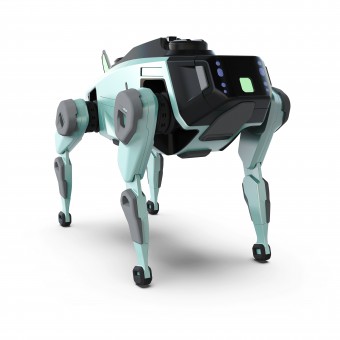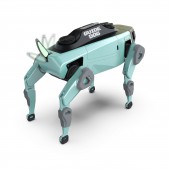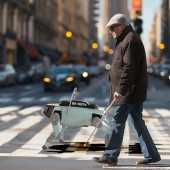DESIGN NAME:
Robuddy
PRIMARY FUNCTION:
Autonomous Guide Dog
INSPIRATION:
Inspired by the loyalty and assistance of real guide dogs, Robuddy seeks to replicate their impact through innovative technology. Merging functionality with emotional support, Robuddy aims to redefine accessibility for individuals with visual or auditory impairments. Addressing a common challenge faced by traditional guide dogs, Robuddy ensures unwavering focus and reliability, free from distractions that may hinder real dogs.
UNIQUE PROPERTIES / PROJECT DESCRIPTION:
Robuddy is an autonomous robot guide dog,inspired by a mission to empower those with visual or auditory impairments. Embracing the profound impact of traditional guide dogs, the project melds advanced technology with empathy to provide not only functional assistance but also emotional support. Through innovative navigation and communication systems, this project envisions a future where inclusivity and independence converge, redefining the landscape of assistive devices.
OPERATION / FLOW / INTERACTION:
Users control it through a user-friendly smartphone app or simple gestures. For deaf users, information appears on built-in screens and also the smartphone app, while blind users receive guidance through Bluetooth earphones and movement feedback from the collar. It mimics real dog behavior, responding to commands and offering companionship, making it an intuitive and accessible assistive companion for those with visual or auditory impairments. Integrated screens on both the body and face areas are used to also communicate with people around if needed. The tail acts as a status light to show Robuddy's status to people nearby.
PROJECT DURATION AND LOCATION:
The projects first development started in 2021 in Ankara, and for this version, it finished in December 2023.
|
PRODUCTION / REALIZATION TECHNOLOGY:
The main structure which carries main components and batteries is made from lightweight titanium. The outer shell's production methods consists of additive manufacturing as well as plastic molding proccesses. Plastics such as polycarbonate are used to achieve semi-transparency in parts where integrated screens, sensors and cameras are placed.
SPECIFICATIONS / TECHNICAL PROPERTIES:
Width 840 mm x Depth 440 mm x Height 597 mm
TAGS:
Autonomous, Robotics, Guide Dog, Assistive Technology, Accessibility Innovation
RESEARCH ABSTRACT:
-
CHALLENGE:
The social impact side of things was to reduce any risk of animal abuse while training. A robot guide dog won't experience pain or stress, making it less susceptible to abusive practices. This can be especially relevant in situations where sadly, trainers might resort to harsh methods.
The challenge in the design process was to create a robot guide dog within real dog dimensions. Balancing intricate technology, sensors, and maintaining a compact size demanded meticulous engineering.
ADDED DATE:
2024-02-27 13:11:34
TEAM MEMBERS (5) :
Designer : Ufuk Oğul Dülgeroğlu, , Team Members : Nurullah Taşkıran, Dilan Eryiğit, Hamdi Hekimoğlu, Dilay Buse Kökoğlu, Emre Can Özgür, and Supervisor : Özgür Ülvan
IMAGE CREDITS:
Ufuk Oğul Dülgeroğlu, 2023.
|









